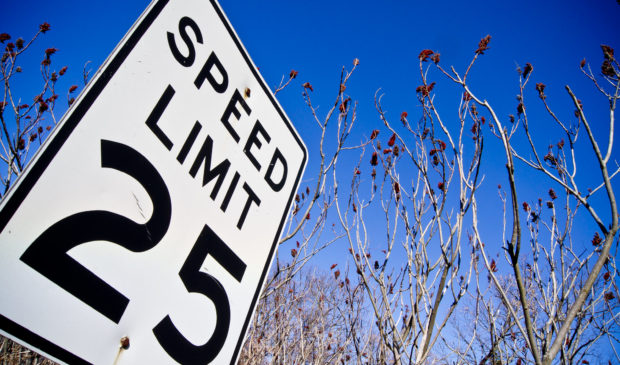City could see sharp decline in traffic fatalities after speed limit reductions
Monday, June 22, 2020 by
Nina Hernandez City Council recently made a decision to decrease speed limits to 25 mph on most residential streets. Now it’s up to the Transportation Department to implement the new limits, educate the public and partner with the Austin Police Department to enforce them.
Eric Bollich, Transportation’s managing engineer, said the department is working on a deployment schedule for new signage, and is looking at neighborhoods that already have 25 mph signs (a past city effort) and 30 mph signs to help it prioritize.
The new signs may come with supplemental yellow signs emblazoned with “Notice” or “New,” red borders or flags, flashing beacons, reflective materials or dynamic speed display devices.
Bollich said it’s hard to predict what effect the changes might have on the city’s traffic fatality statistics, which hit 86 last year. He pointed to other cities that have tried similar tactics.
“There was a study in Boston showing that the odds of somebody traveling over 35 mph has decreased by about 30 percent,” he said. “Their effort was mainly signage change like we recently passed in Austin.”
That’s significant because crash victims are less likely to be fatally injured if the vehicle was traveling at 35 mph or less. In the three years since Boston adopted Vision Zero and lowered its speed limits, it has cut traffic fatalities in half.
Transportation planner Joel Meyer said the department isn’t devoting any new resources or implementing any specific initiatives around enforcing these speed changes, but that any time the department changes limits it informs law enforcement interests. That doesn’t mean APD will be cracking down on drivers with increased tickets.
“We encourage APD, and I think they feel the same way, that it’s always good to start with warnings when you have big changes like this,” Meyer said, explaining that drivers should be given time to adjust. “So we definitely encourage the use of warnings rather than citations in order to get that behavior change.”
Meyer said the city understands that there are “necessary and important” policy conversations happening in the community and in the nation at large regarding the role law enforcement plays in our communities.
“When done correctly, enforcement can play a key role in reinforcing safe travel behaviors and reducing severe crashes,” he said. “But we also know that there are disparities in how traffic laws are enforced that need to be taken into consideration. We also know that minority communities, and particularly the black community, is substantially overrepresented in the crash statistics. So we will continue to have these important conversations about the appropriate role of law enforcement in Vision Zero to find the right balance.”
Along with social media outreach and working in conjunction with the Austin Police Department’s Public Information Office, the Transportation Department is passing out yard signs in affected neighborhoods to help get the word out about the changes and stress to motorists the importance of watching out for children.
This is the first time in over a decade that the city has reduced speed limits on neighborhood streets in an overhaul of this fashion. Several years ago, the city began to change limits on some neighborhood streets to 25 mph, but those changes were soon abandoned.
“This is a renewed effort to take a look and recommend appropriate speed limits citywide,” Bollich said. “So we’re taking a look at it again and we’re hoping to make an impact across the city.”
Neighborhood streets and those inside the urban core were given priority in this round of changes, but the city is also working to decide on changes to the speed limits of roads outside the urban core.
According to a recent memo, the department should conclude an engineering analysis of streets outside the urban core and make recommendations for speed limit changes as soon as spring 2021. However, that could be delayed due to the Covid-19 pandemic and resulting reduced traffic volumes and behaviors.
Photo made available through a Creative Commons license.
The Austin Monitor’s work is made possible by donations from the community. Though our reporting covers donors from time to time, we are careful to keep business and editorial efforts separate while maintaining transparency. A complete list of donors is available here, and our code of ethics is explained here.
You're a community leader
And we’re honored you look to us for serious, in-depth news. You know a strong community needs local and dedicated watchdog reporting. We’re here for you and that won’t change. Now will you take the powerful next step and support our nonprofit news organization?










